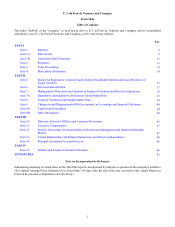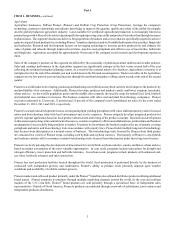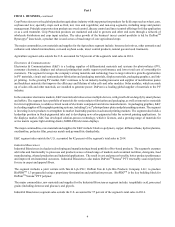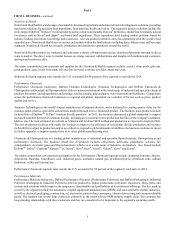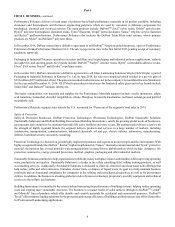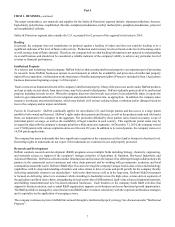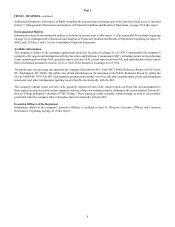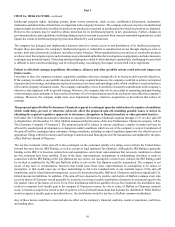DuPont 2014 Annual Report Download - page 12
Download and view the complete annual report
Please find page 12 of the 2014 DuPont annual report below. You can navigate through the pages in the report by either clicking on the pages listed below, or by using the keyword search tool below to find specific information within the annual report.Part I
ITEM 1A. RISK FACTORS, continued
11
Market acceptance, government policies, rules or regulations and competition could affect the company's ability to generate
sales from products based on biotechnology.
The company is using biotechnology to create and improve products, particularly in its Agriculture and Industrial Biosciences
segments. These products enable cost and process benefits, better product performance and improve environmental outcomes to
a broad range of products and processes such as seeds, animal nutrition, detergents, food manufacturing, ethanol production and
industrial applications. The company's ability to generate sales from such products could be impacted by market acceptance as
well as governmental policies, laws and regulations that affect the development, manufacture and distribution of products,
particularly the testing and planting of seeds containing biotechnology traits and the import of crops and other products derived
from those seeds.
In order to maintain its right to sell existing products or to commercialize new products containing biotechnology traits, particularly
seed products, the company must be able to demonstrate its ability to satisfy the requirements of regulatory agencies. Sales of
seeds with biotechnology traits into jurisdictions where planting has been approved could be affected if key import markets have
not approved the import of crops containing such biotechnology traits. If import occurs in these markets, it could lead to disruption
and potential liability for the company.
The regulatory environment is lengthy and complex with requirements that can vary by industry and by country. The regulatory
environment may be impacted by the activities of non-governmental organizations and special interest groups and stakeholder
reaction to actual or perceived impacts of new technology on safety, health and the environment. Obtaining and maintaining
regulatory approvals requires submitting a significant amount of information and data, which may require participation from
technology providers. Regulatory standards and trial procedures are continuously changing. The pace of change together with the
lack of regulatory harmony could result in unintended noncompliance. In addition, the company’s compliance could be affected
by the detection of low level presence of biotechnology traits in conventional seed or products produced from such seed.
Furthermore, the detection of biotechnology traits not approved in the country of planting may affect the company’s ability to
supply product and could affect exports of products produced from such seeds and even result in crop destruction or product
recalls.
The company's business, including its results of operations and reputation, could be adversely affected by process safety
and product stewardship issues.
Failure to appropriately manage safety, human health, product liability and environmental risks associated with the company's
products, product life cycles and production processes could adversely impact employees, communities, stakeholders, the
environment, the company's reputation and its results of operations. Public perception of the risks associated with the company's
products and production processes could impact product acceptance and influence the regulatory environment in which the company
operates. While the company has procedures and controls to manage process safety risks, issues could be created by events outside
of its control including natural disasters, severe weather events, acts of sabotage and substandard performance by the company's
external partners.
As a result of the company's current and past operations, including operations related to divested businesses, the company
could incur significant environmental liabilities.
The company is subject to various laws and regulations around the world governing the environment, including the discharge of
pollutants and the management and disposal of hazardous substances. As a result of its operations, including its past operations
and operations of divested businesses, the company could incur substantial costs, including remediation and restoration costs. The
costs of complying with complex environmental laws and regulations, as well as internal voluntary programs, are significant and
will continue to be so for the foreseeable future. The ultimate costs under environmental laws and the timing of these costs are
difficult to predict. The company's accruals for such costs and liabilities may not be adequate because the estimates on which the
accruals are based depend on a number of factors including the nature of the matter, the complexity of the site, site geology, the
nature and extent of contamination, the type of remedy, the outcome of discussions with regulatory agencies and other Potentially
Responsible Parties (PRPs) at multi-party sites and the number and financial viability of other PRPs.


